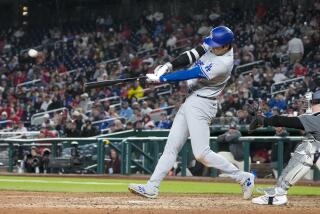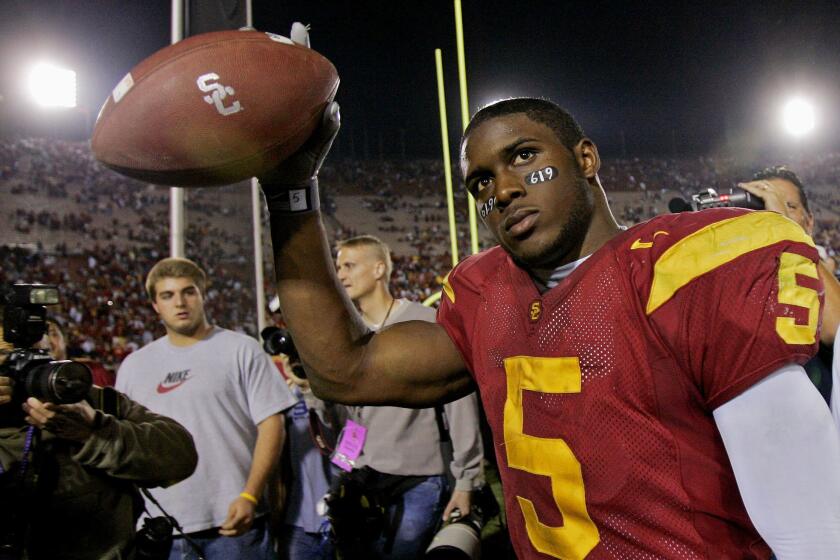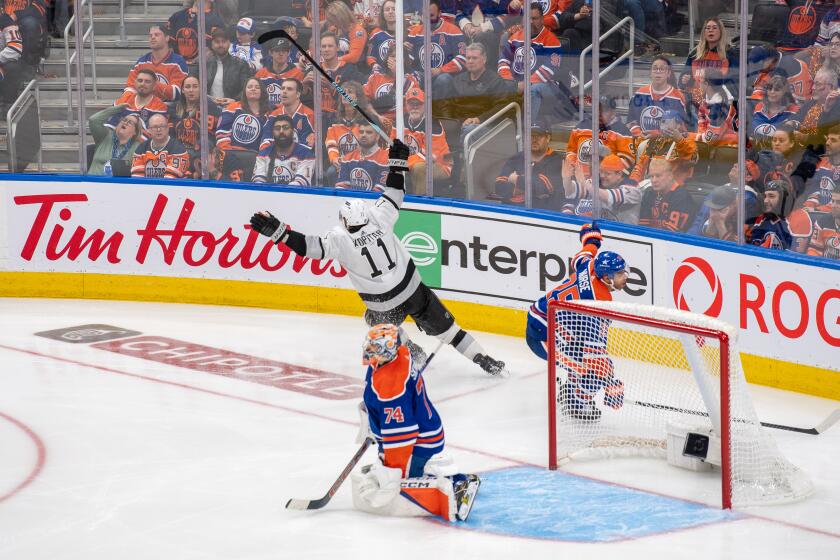Traveling at the Speed of Fright
My guy Sebastien Bourdais -- mon ami -- took the checkered flag at the Toyota Grand Prix of Long Beach on Sunday.
Sportswriters aren’t supposed to take a rooting interest, but I’ve never covered someone who had my life in his hands before.
Twelve days before he won the Grand Prix, Bourdais took me and a few other journalists on the rides of our lives around the Long Beach course in a special two-seat car. The simple fact that I lived to write about it made the 26-year-old Frenchman my new favorite driver.
But I had a newfound respect for all of the drivers.
It didn’t take long into our test ride, about two turns or so, to realize ... you can’t do this. It’s like hitting .300 against major league pitching or shooting in the 60s on any golf course you encounter, a skill set that belongs only to a select group.
It took all I had just to hold the grips. To actually control the car while your stomach keeps jumping up into your throat and you’re pulling five Gs on the turns and the air is rushing by so fast on the straightaway that it feels like your strapped-on helmet will fly off
And remember, one lapse of concentration at 200 mph could mean death. Not some time on the bench for making a dumb mistake, or a stint on the injured list. Death.
That’s the most underrated quality of these drivers. Yes, the bravery -- maybe even foolishness -- gets them in the car, but it’s their mental sharpness that keeps them alive. Two laps in the passenger seat was as draining as it was exhilarating for me. They do it for 81 laps over an hour and 45 minutes.
Just as remarkable is their nonchalance. Before and after the journalists climbed in and out of his car, their faces filled with a mix of excitement, fear and awe, Bourdais seemed remarkably relaxed. Almost bored.
“This is what I do,” he said.
Last year he did it better than anyone on the Champ Car circuit, winning the 2004 series championship.
And Sunday he was the best in the field thundering through the shore-side streets of Long Beach. He started in the fourth position, but he managed to pass the pole-sitter and early leader Paul Tracy on the 38th lap.
Pit stop timing and speediness and choosing when to use the two available types of tires all factor into winning this race. So do split-second decisions.
What we might think of as the difference between life and death is the difference between victory and defeat for them.
“One-tenth of a second is like blinking your eye,” said Tracy, the runner-up. “Sometimes that’s what separates the top three guys.”
“This street course, “ Bourdais said. “It takes so little to be fantastic or ... be the worst moment of your life.”
Bourdais saw his chance on Tracy in Turn 1, managed to get by him without using the 50 horsepower boost from his “Push to Pass” button, then crowed to his crew on the radio: “How about that?”
How about adding his name to the list of Long Beach winners that includes Mario Andretti and Al Unser Jr.?
“To win is great, especially here, because it’s a tremendous racetrack and great champions have won here,” Bourdais said.
It didn’t even hit me until Sunday that now I have a little bit in common with those great racers too: the experience of zooming down Shoreline Drive in an open cockpit.
The two-seater has the same 750-horsepower engine as the competition Champ cars, but it’s taller, heavier and longer, and its top speed of 175 mph is about 50 mph slower than the racing cars.
Obviously it was the highest-performance vehicle I’d sat in, but to Bourdais it handled like “a van.”
Still, he drove the only way he knows: all out. It wasn’t the speed that seemed so different. I’ve topped 100 mph before, although it was in a rental car on a darkened, empty highway in Indiana.
The acceleration is what takes your breath away. These cars go from 0 to 100 in four seconds. Television doesn’t come close to capturing the sensation. Even watching them zoom by you in person doesn’t prepare you for it.
Compared with the ol’ Camry, it felt like a jet fighter taking off. And just like that it was time to decelerate for Turn 1. In these cars, there’s no time to think. There’s always a curve ahead. By the time you think about it, you’re in it.
(Since I wasn’t driving, I also had the “luxury” of thinking about how awful it would be to hit the walls at those speeds).
And this was on an empty track. Imagine doing it with 18 other cars out there, some of them taking those turns at the same time as you. And you’re wearing a helmet that restricts your peripheral vision. That’s why, when I asked Bourdais how he keeps tabs on the whereabouts of the other cars, he admitted, “You kind of guess.”
And you know what’s the hard part for him? Going home, with all those speed limit signs and slow cars.
“I have absolutely no fun driving in the street cars,” Bourdais said after the race. “It’s probably more dangerous to drive in the traffic.”
I told him I saw a Bronco flipped over on the 710 Freeway on the way down.
“No crashes out there today,” he said, gesturing back at the track. A couple of spinouts into the tires, a couple of stalls, but no bad crashes.
I was rooting for Bourdais to avoid the walls or an engine stall Sunday.
Almost as much as I was rooting for him to get around the track two times without incident on March 29.
J.A. Adande can be reached at j.a.adande@latimes.com. To read previous columns by Adande, go to latimes.com/adande.
More to Read
Get our high school sports newsletter
Prep Rally is devoted to the SoCal high school sports experience, bringing you scores, stories and a behind-the-scenes look at what makes prep sports so popular.
You may occasionally receive promotional content from the Los Angeles Times.






